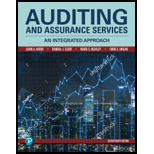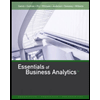
a.
Determine the appropriate non-statistical
b.
Determining the initial sample size needed to satisfy the auditor’s requirements using attributes sampling.
c.
Determining the effect on initial sample size when the factors change separately keeping the other factors held to be constant. The factors that change are an increase in ARO, an increase in the TER, an increase in the EPER, and an increase in the population size.
d.
Identify the reason for the large difference in the sample sizes for columns 3 and 6.
e.
Identify the factor which appears to have the greatest effect on the initial sample size and one that appears to have the least effect among the four factors by comparing the results of part c with part a or part b.
f.
Explain the reason of calling the sample size as the initial sample size.
Want to see the full answer?
Check out a sample textbook solution
Chapter 15 Solutions
EBK AUDITING+ASSURANCE SERVICES
- Please help me solve this general accounting question using the right accounting principles.arrow_forwardCan you explain the correct methodology to solve this general accounting problem?arrow_forwardWhat role does assurance boundary definition play in attestation? (a) Standard limits work always (b) Boundaries never matter (c) Engagement scope limits determine verification responsibilities (d) All areas need equal coverage MCQarrow_forward
- Please help me solve this general accounting question using the right accounting principles.arrow_forwardPlease explain the solution to this general accounting problem using the correct accounting principles.arrow_forwardCan you demonstrate the accurate method for solving this financial accounting question?arrow_forward
 Essentials of Business Analytics (MindTap Course ...StatisticsISBN:9781305627734Author:Jeffrey D. Camm, James J. Cochran, Michael J. Fry, Jeffrey W. Ohlmann, David R. AndersonPublisher:Cengage Learning
Essentials of Business Analytics (MindTap Course ...StatisticsISBN:9781305627734Author:Jeffrey D. Camm, James J. Cochran, Michael J. Fry, Jeffrey W. Ohlmann, David R. AndersonPublisher:Cengage Learning Auditing: A Risk Based-Approach (MindTap Course L...AccountingISBN:9781337619455Author:Karla M Johnstone, Audrey A. Gramling, Larry E. RittenbergPublisher:Cengage Learning
Auditing: A Risk Based-Approach (MindTap Course L...AccountingISBN:9781337619455Author:Karla M Johnstone, Audrey A. Gramling, Larry E. RittenbergPublisher:Cengage Learning

